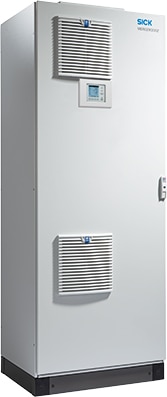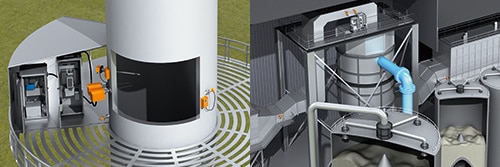The impending updates to the BREF documents have indicated that mercury emissions from large combustion plants will soon have to be reduced dramatically. However, a reliable measurement solution is already ready and waiting with a certified measuring range from 0 to 10 μg/m³ of mercury. The MERCEM300Z by SICK.
In the field of emissions monitoring, mercury (Hg) is one of the elements that is moving further and further into public focus. Large combustion plants have also found themselves in the spotlight - this refers to industrial plants with a rated thermal input of 50 megawatts and above and which are used to convert energy from fossil and biogenic energy sources.
New limit values for mercury emissions
It is not yet fully clear how strict the mercury emissions limits for large combustion plants in Europe will be. This will be published in the updated LCP BREF (Large Combustion Plant Best Available Techniques Reference Document), a document prepared by the European Commission which describes the best available technology (BVT) for each field of industry in a bid to prevent and reduce environmental impact. Forecasts believe that the average annual Hg emission limit values for hard-coal fired power plants in Europe will be reduced to between 1 and 4 μg/m³ and to between 4 and 7 μg/m³ for lignite power plants. These emission hard-coal fired power plants will then apply to both new and existing power plants. The current limit values for Europe are between 30 μg/m³ and 50 μg/m³. The USA is currently leading the field with mercury limits of around 1.5 to 2.3 μg/m³ for coalbased power plants. However, unlike the annual average used in Europe, this figure is based on a 30-day average.
Best available measurement technology
The BREF documents describe the best available technologies and consumption data alike, making them a reference for authorities across Europe when approving industrial plants. So how well equipped are plant operators in terms of the measurement technology needed to adhere to the new limit values and safely monitor their mercury emissions? If they are in fact going to be ratified and implemented within the EU, the limit value targets set out in the current BREF documents are a huge leap forward when it comes to reducing mercury emissions, says Florian Greiter, Product Manager at SICK. It will all boil down to power plants investing in improved gas purification methods and even more accurate emission measurement technology. We have everything that power plants need to tackle these new challenges: the MERCEM300Z mercury gas analyzer.

The MERCEM300Z is a continuous analyzer with the lowest certified measuring range of 0 to 10 μg/m³ so that it is ready and waiting to tackling the mercury measurement needs of tomorrow. Its large range means that it can even tackle measuring ranges from 0 to 1,000 μg/ m³, making it ideal for raw gas measurements. Because everything needs checking and testing, it has been tested for suitability in accordance with EN 15267. In the EU, suitability testing is always carried out on two identical systems and consists of a lab test with subsequent field tests. A suitability test for a 1-component CEMS (continuous emission monitoring system) lasts between 6 and 14 months in total. During the field tests, the analyzer is required to prove its compatibility in waste incineration plants, cement plants, and power plants. It is not particularly easy to draw comparisons between measurement requirements and limit values in Europe and the USA. In the USA, each individual CEMS is tested according to Performance Specification 12A (PS 12A) within the first few weeks after commissioning. Certification prior to commissioning, which is what happens in a suitability test, does not take place. The two regions also differ in that mercury emissions in the USA have to be monitored as a monthly average instead of as a daily mean. SICK has already delivered a number of MERCEM300Zs to the USA. These have been successfully calibrated according to PS 12A and can even monitor mercury emissions below 1 μg/m³.
 1.The MERCEM300Z monitors Hg emissions with a high level of availability in accordance with official national and international requirements. 2. The MERCEM300Z accurately detects Hg concentration in raw gas.
1.The MERCEM300Z monitors Hg emissions with a high level of availability in accordance with official national and international requirements. 2. The MERCEM300Z accurately detects Hg concentration in raw gas.
Groundbreaking mercury measurement
Additional measures must be incorporated into plant processes if the more stringent limit values are to be complied with over the long term. With the MERCEM300Z, plant operators can detect unpredicted Hg peaks during the combustion process at an early stage. Taking measurements in the raw gas before the scrubber also has its benefits: Measures to reduce Hg levels can be applied immediately so that there are no nasty surprises in the stack at the end of the process. Furthermore, the operator is also able to check and cut costs by adding exactly the right amount of activated carbon and coagulant to the raw gas. The MERCEM300Z is even equipped to deal with the high dust loads and higher concentration of interfering compounds that occur in the raw gas. As a result, it delivers quick and reliable measurement results at all times. Due to its low-maintenance design and simple operating concept, it can monitor mercury concentration in the long term and with a high level of measurement certainty.
- Product information: MERCEM300Z
- Product portfolio: Gas analyzers


